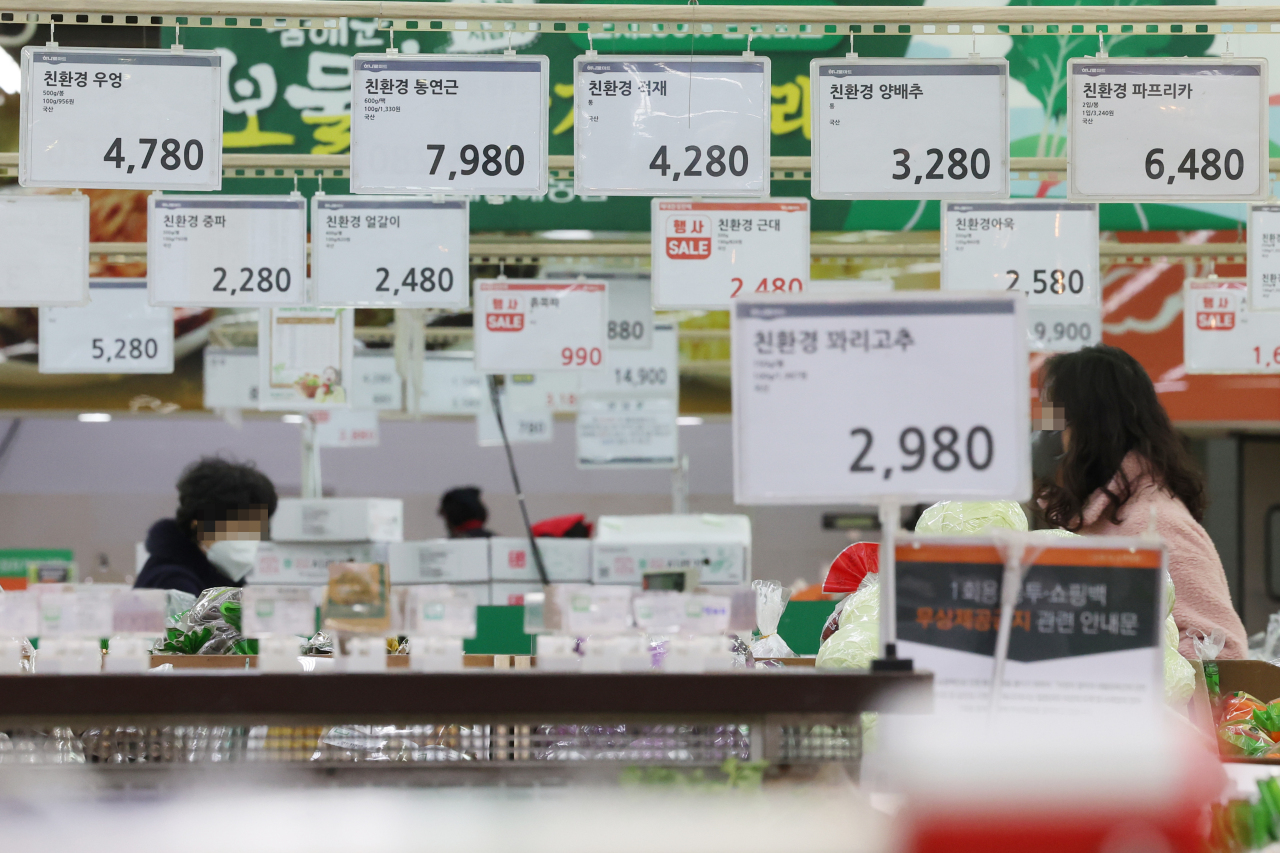[Newsmaker] Consumer prices grow over 3 percent for 4 consecutive months
By Kim Yon-sePublished : Feb. 4, 2022 - 16:02

SEJONG -- The nation’s consumer prices climbed 3 percent or more for the fourth consecutive month, despite the Bank of Korea’s three interest rate hikes between August 2021 and January.
Statistics Korea said Friday that consumer prices grew 3.6 percent in January, compared to a year earlier. After the growth breached a 3 percent threshold -- 3.2 percent -- for the first time in more than nine years in October, it rose to 3.8 percent in November and 3.7 percent in December.
This marked the first time in about a decade that consumer price growth recorded over 3 percent for four consecutive months, since during 2011-2012, according to data from the state agency.
Prices for dining out and petroleum products led the inflation in January.
Prices for dining out rose 5.5 percent on-year, and sashimi and beef prices at restaurants surged by 9.4 percent and 8 percent, respectively.
Those of petroleum products climbed 16.4 percent amid another spike in international crude prices: 12.8 percent in gasoline, 16.5 percent in diesel and 34.5 percent in liquefied petroleum gas.
A 6.3 percent growth was seen in products of agriculture, livestock and fisheries. Among livestock products that saw a 11.5 percent rise, pork saw a 10.9 percent jump, imported beef 24.1 percent and eggs 15.9 percent. Agricultural products rose by 4.6 percent, involving a 45.1 percent spike for strawberries.
In addition, prices of power, gas and water posted the highest growth -- 2.9 percent -- in more than four years since September 2017. Electricity rose 5 percent on-year and water by 4.3 percent.
By region, Jeju Province topped the list with a 4.6 percent growth among the 17 major cities and provinces. Gangwon, North Gyeongsang and South Chungcheong provinces also posted within a 4 percent range, at 4.3 percent, 4.2 percent and 4 percent, respectively.
The next on the list were Sejong and Incheon at 3.9 percent, South Jeolla Province at 3.8 percent and Gyeonggi Province, Daegu and South Gyeongsang Province at 3.7 percent. Seoul with 3.1 percent placed under the nationwide average of 3.6 percent.
Deputy prime minister and Finance Minister Hong Nam-ki said Friday the local market has been affected by global inflationary pressures.
He attributed the continuous high growth in consumer prices to “a sharp growth in import prices of raw materials.”
Statistics Korea said Friday that consumer prices grew 3.6 percent in January, compared to a year earlier. After the growth breached a 3 percent threshold -- 3.2 percent -- for the first time in more than nine years in October, it rose to 3.8 percent in November and 3.7 percent in December.
This marked the first time in about a decade that consumer price growth recorded over 3 percent for four consecutive months, since during 2011-2012, according to data from the state agency.
Prices for dining out and petroleum products led the inflation in January.
Prices for dining out rose 5.5 percent on-year, and sashimi and beef prices at restaurants surged by 9.4 percent and 8 percent, respectively.
Those of petroleum products climbed 16.4 percent amid another spike in international crude prices: 12.8 percent in gasoline, 16.5 percent in diesel and 34.5 percent in liquefied petroleum gas.
A 6.3 percent growth was seen in products of agriculture, livestock and fisheries. Among livestock products that saw a 11.5 percent rise, pork saw a 10.9 percent jump, imported beef 24.1 percent and eggs 15.9 percent. Agricultural products rose by 4.6 percent, involving a 45.1 percent spike for strawberries.
In addition, prices of power, gas and water posted the highest growth -- 2.9 percent -- in more than four years since September 2017. Electricity rose 5 percent on-year and water by 4.3 percent.
By region, Jeju Province topped the list with a 4.6 percent growth among the 17 major cities and provinces. Gangwon, North Gyeongsang and South Chungcheong provinces also posted within a 4 percent range, at 4.3 percent, 4.2 percent and 4 percent, respectively.
The next on the list were Sejong and Incheon at 3.9 percent, South Jeolla Province at 3.8 percent and Gyeonggi Province, Daegu and South Gyeongsang Province at 3.7 percent. Seoul with 3.1 percent placed under the nationwide average of 3.6 percent.
Deputy prime minister and Finance Minister Hong Nam-ki said Friday the local market has been affected by global inflationary pressures.
He attributed the continuous high growth in consumer prices to “a sharp growth in import prices of raw materials.”


















![[Today’s K-pop] Treasure to publish magazine for debut anniversary](http://res.heraldm.com/phpwas/restmb_idxmake.php?idx=642&simg=/content/image/2024/07/26/20240726050551_0.jpg&u=)